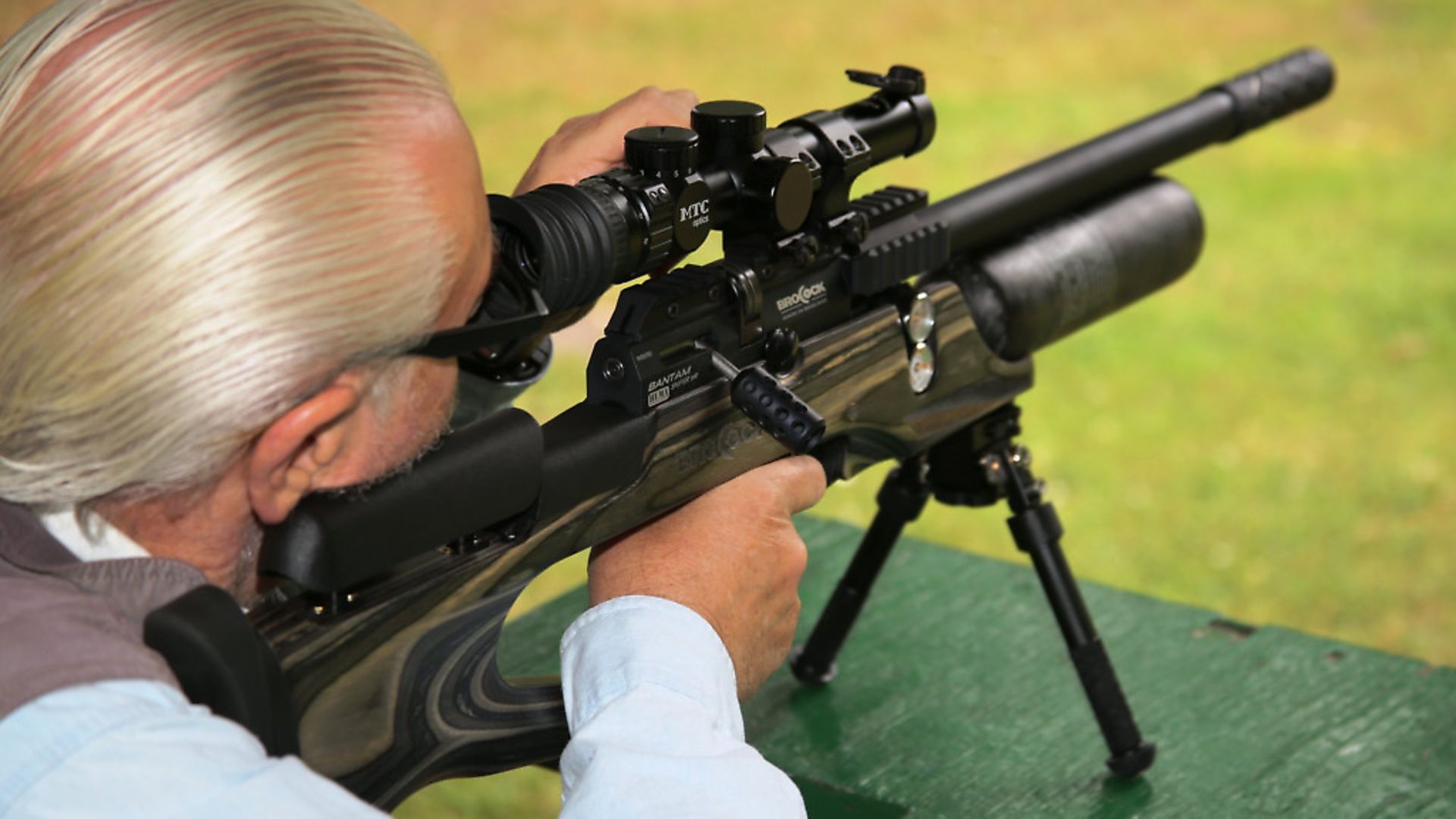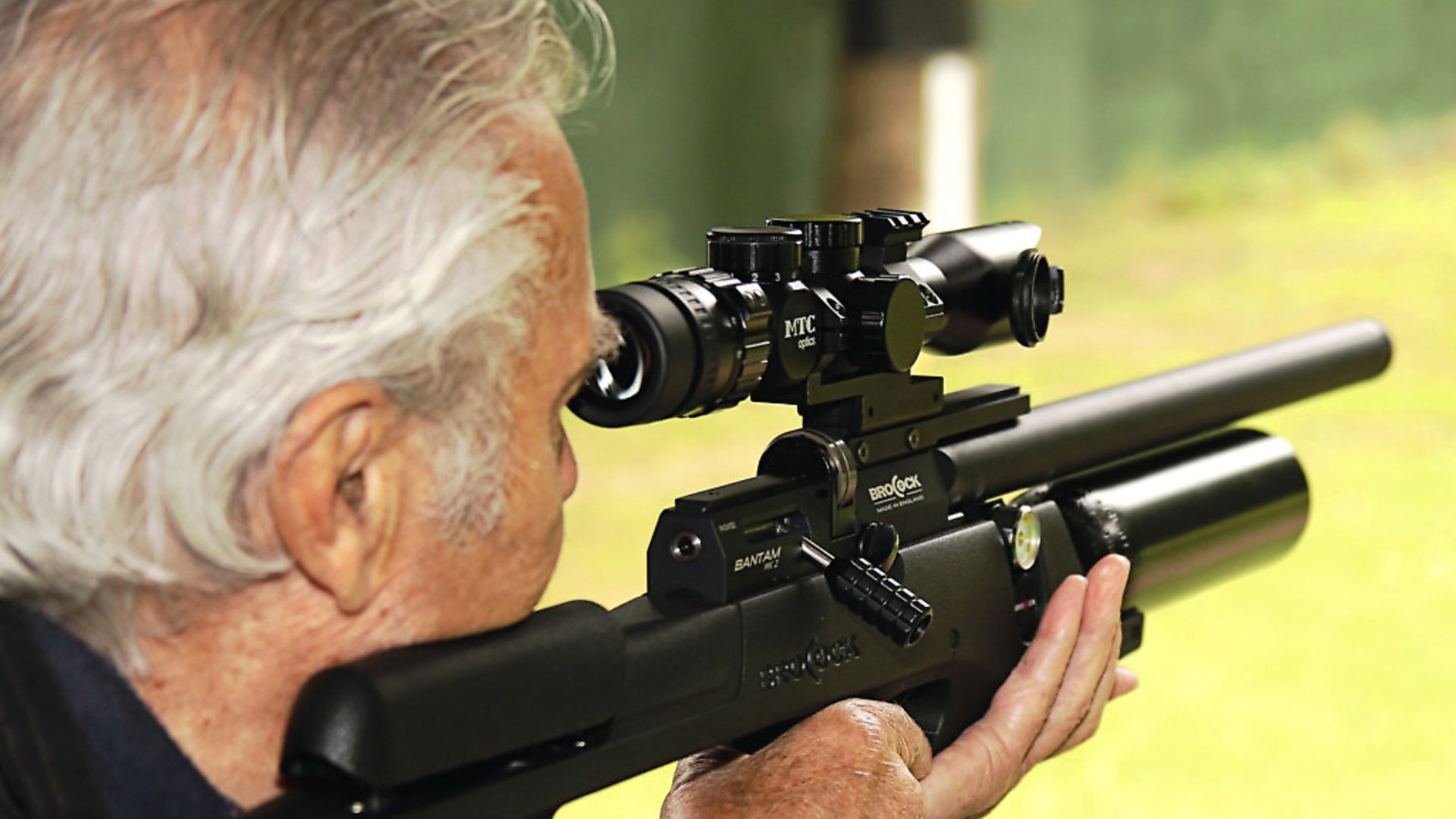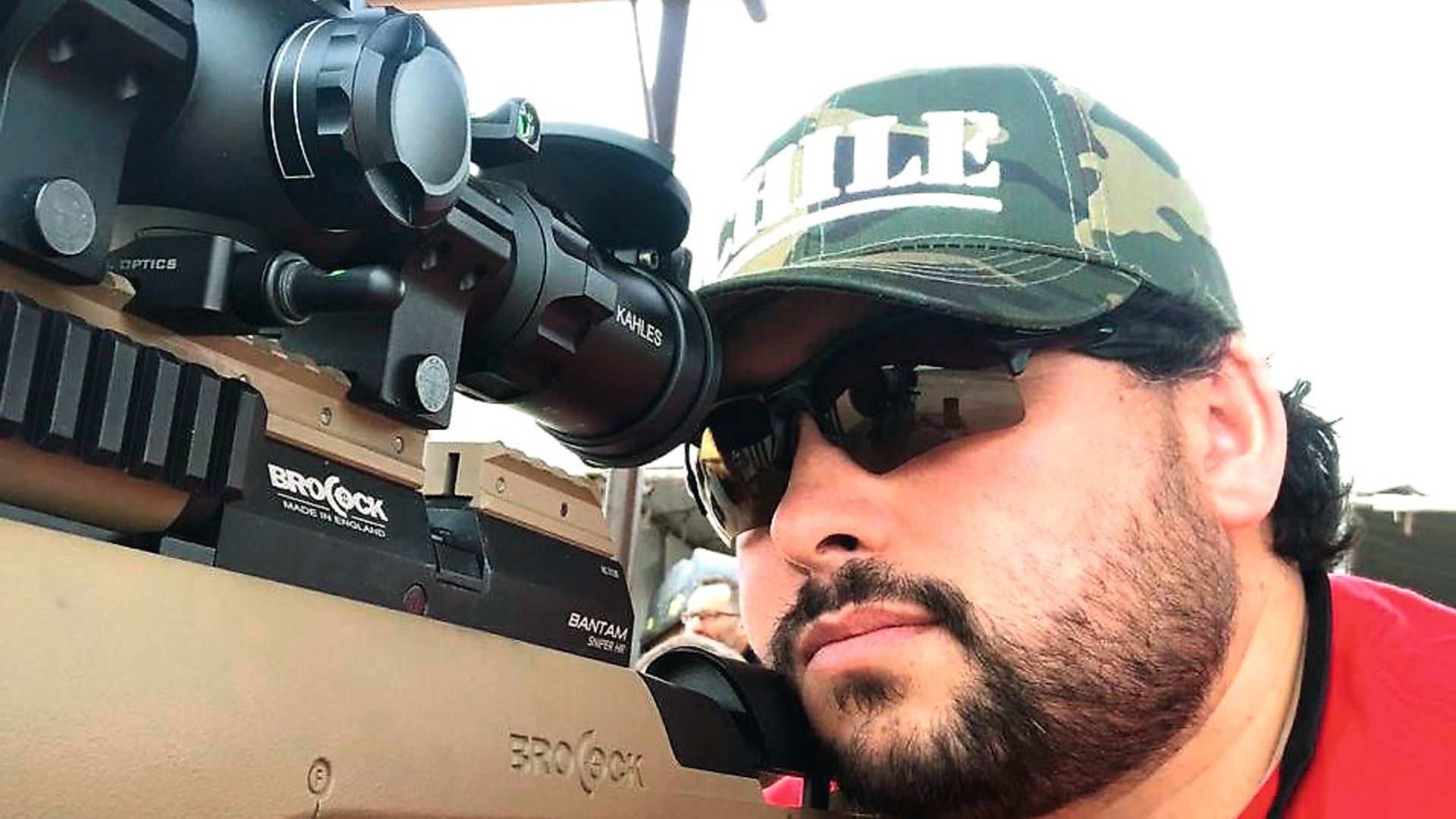The editor finds out plenty about his shooting desires, via a brace of Brocock Bantams
 credit: Archant
credit: Archant
This test format sprang into life as simplicity itself; I would shoot a pair of the latest Mk II Brocock Bantams, one top-of-the-range Sniper HR model with a laminate stock and a stack of optional extras bolted to it, the other a completely standard Bantam, and decide if the tricked out one was really worth the extra investment.
This basic, practical brief lasted a full ten minutes after I began to shoot the Bantams, and fell apart completely as soon as I asked the opinions of some shooting friends whose judgement I respect. What emerged as the main topic of this test, was not the relative performance merits of these rifles, but their users' mindset, attitude and priorities as far as their shooting was concerned.
The debates surrounding these rifles taught me a great deal about where I am with my sport, and possibly my life. It's profound stuff for a simple airgun test, and I'd like you to get involved by thinking about the points raised in this review, and letting me know about them. For now, though, let's take a close look at the new Bantams and see what they're all about.
 credit: Archant
credit: Archant
Cocks of the walk
Since the Diana Group, which also owns Daystate, acquired Brocock in 2014, there has been a shift in the 'identity' of the Brocock air rifle. Bar the odd 'O' ring, today's Brococks share no components of any kind with the Daystate range. The Bantam MKII Sniper HR not only represents the flagship of Brocock's 'semi-bullpup' range, but it also embodies the company's aspirations, not to mention another firm declaration that Brocock is entirely its own brand, and not 'Daystate lite'. In fact, by the time I fully explain the details of the hardware in this test, it will be obvious that, as far as performance and price goes, these Brococks aren't 'lite' in any way at all.
 credit: Archant
credit: Archant
The Bantam MKII
I'm still not entirely sure when a carbine became a semi-bullpup, but the action of the Bantam is set a little further back in the stock than that of a conventional sporter, so I'm going with that. The semi-bullpup status could be an important sales point, due mainly to those who really can't entertain the idea of shooting, and owning, the Marmite of formats that is undoubtedly the bullpup. Bantams definitely don't feel 'bullpuppy', and if that's a good thing in your world, you already need to take a close look at these guns.
What you'll see is a pre-charged pneumatic, 10-shot rifle, housed in an ambidextrous, black, synthetic thumbhole stock, with an adjustable-height cheek piece and butt pad, and it runs off a high-capacity, 400 cc, aluminium, buddy-bottle air reservoir that can be charged in seconds, courtesy of the push-fit connector located beneath the rifle's fore end and protected by a magnetic cover. There's also a power adjuster, although this feature only really comes into its own in the high-power variations.
 credit: Archant
credit: Archant
A full-length shroud, threaded to take a moderator, covers the 17-inch, match barrel and augments the rifle's optional silencer; its scope rails are standard 11mm, and the trigger is a precision, two-stage unit, backed by a manual safety catch.
Inside the Bantam MKII, Steve Harper's patented Slingshot Hammer system maximises output, minimises valve bounce, and as a result, ensures shot-to-shot consistency.
The Bantam MKII is a, matte-black study in chunky practicality. The magazine is identical WWW to the foolproof system used by Daystate, and the .177 test sample grouped Air Arms Diabolo Field pellets inside 19 mm at 45 yards. In more basic terms, even in its comparatively basic form, this rifle does the business. Now let's see what the whistles and bells of the Sniper HR model bring to the performance party.
 credit: Archant
credit: Archant
The Bantam MKII Sniper HR
To the MKII mix, now add the following: a Huma regulator, a blue-grey laminated version of the standard stock, from Italian maestros, Minelli, a neat little 0dB Piccolo silencer, a cluster of Picatinny accessory rails to match the scope rail option, a 480cc carbon-fibre air tank, and an Alpha bipod, and the price of the Bantam MKII has risen from its standard £849, to a distinctly super-sporter'ish tag of … £1, 515.
Serious money, then, but these Bantams are serious items of air-powered hardware.
 credit: Archant
credit: Archant
How the Bantams perform
Before I compare and contrast the experience of shooting the standard with the blinged-up Bantam, we need to see some more basic facts and figures. First, with its muzzle energy set to 11-plus ft.lbs. with an 8.4 grain pellet, the unregulated rifle produces 280 shots from its 400cc air tank in .22, and 250 in .177. The fully-regulated HR Sniper and its larger capacity 480cc carbon tank raises the shot count to 520 in .22, and 410 in .177. I know I don't really have to say this, but both models produce a ton of shots for sub-12 users, and even high-power FAC-rated Sniper HRs will still yield 55 shots in .25 calibre when set at 46 ft.lbs.
Consistency is as consistency does
Obviously, the regulated Bantam will have a significantly more consistent output than its standard stablemate. According to the test samples, the HR in .22 and the standard in .177, that Huma reg' maintains a steady 7 f.p.s. spread over the first 50 shots, whereas the unregulated rifle, with its Slingshot valve system flying solo, manages an extremely credible 14 f.p.s. over the same number of shots. This convenient disparity begs the question, 'is the regulated version twice as good as the standard item?' The answer to that is a refreshingly simple, 'no it isn't.'
Regulators in the real world
Shooting these rifles side by side, I defy anyone to tell apart the groups shot by each at all realistic ranges. The factory spec' MKII will match its posher version pellet for pellet, where it counts, downrange. Also, regulators are hi-tech items and whilst the Huma is supremely reliable, it's still something else that needs to function flawlessly over thousands of shots. Many airgunners prefer the uncomplicated life of unregulated output, and I can definitely see the sense in that. Those of a technical bent and shooters running FAC-rated rifles will appreciate the Bantam HR's regulator for the 'flattening' effect it has on the power curve, so we can already see a 'horses for courses' theme developing, here.
Fit, form and function
I never cease my drone about the importance of a properly fitting rifle and both Bantams work with me toward my quest on this subject. The combination of adjustable cheek piece and butt pad make more difference to overall performance than any regulator possibly could, and I can only repeat my plea for all new owners of adjustable rifles to take at least a week of solid shooting to get their head-eye-scope relationship properly sorted. Then be prepared to change it to further tweak your alignment.
I found the design of the Bantam stocks allowed a functional relationship with my 'extended' body shape, although I'd prefer the grip to be a little more rounded, so it better filled my palm. For general hunting use, I'd also remove the optional mounting rail from beneath the HR's abbreviated fore end, even if it cost me the use of the bipod. That said, the bipod was perfect for accuracy testing off a bench rest, so again, it's all about those horses and their courses.
Other observations
These rifles have truly excellent triggers. Unusually for me, I tweaked them around a little and set them at a supremely predictable 15-ounce let-off, and whilst others professed a preference for a lighter setting - and that was available - I'm always happier with the 'safer' side of trigger weights. More importantly, this trigger can be set to suit every kind of user, and it will be reliable throughout a huge range of permutations.
That little 0dB Piccolo silencer does a job, too, and it definitely looks the part. Similarly, the magazine system is a tribute to reliable, stylish simplicity. Just drop in each pellet, rotating the inner wheel as you load, and all will be ready to go in under 30 seconds. I cranked the Bantam's bolt as fast as I could, and I couldn't get it to snarl up that magazine's delivery. Again, whoever developed that magazine deserves full credit; it really is a fine feature.
And now comes the reckoning...
As I stated at the outset, I thought this Bantam comparison would be a simple thing, but it's turned out to be anything but; I truly imagined that, humble son of the soil that I am - yes, really - I'd be irresistibly drawn to the rugged practicality of the standard Bantam MKII, mainly because it will do pretty much everything the tricked-out version does, and the money left over would buy me over 650 quid's worth of scope, mounts and rifle case, or I could use the accessories I already have and save my money.
Yes, that's the only way this test was ever going to turn out, especially when the enforced frugality of my airgunning roots pitched in their two-penn'orth and I remembered where I came from. After all, there's no point in spending the old hard-earned when I don't have to, is there? Except it didn't turn out like that at all.
Perceived value
What actually happened, is that I liked the look of the laminated HR considerably more than the plain black of the standard Bantam MKII. Every time I compared those rifles, visually, I was impressed by the Sniper's whole presentation and the impression of efficient style it imparted. Now, style never put a rabbit in a game bag, but these days I'm not shooting for food anywhere near as much as I did when I hunted to supplement the family diet. The fact is, I shoot, own and test airguns mainly for the pleasure the whole process gives me, and anything that increases that pleasure is doing a worthwhile, even essential job for me.
Verdict
The Terry Doe of yesteryear would read what I've just written and his face would form the purest possible expression of scorn, because that version of me is as different then, as these two Brococks are now. Things, people, and airguns evolve, I guess, and I'd now have no hesitation in opting for the Bantam Sniper HR over the standard MKII. Others will undoubtedly choose otherwise, but wherever your priorities find themselves, it's surely great that we have such choices to make.
Next time…
I'll go through each feature and add-on these Brocock Bantams can carry, and evaluate their worth, practical or otherwise. I've been assured I can drag even the post Bantam through anything I like, so I'm looking forward to seeing how my impressions hold up, as well as extending the test of the rifles themselves. See you then.
Specification
Model: Bantam MKII standard and Bantam MKII Sniper HR
Manufacturer: Brocock
Country of origin: UK (Sniper stock produced in Italy)
Price: £849 for the standard MKII, £1,199 for the Sniper HR incl. 480cc carbon bottle
Type: Pre-charged, multi-shot, semi-bullpup sporters
Calibre: .22, .177, .25
Cocking/loading: Bolt-action, via removable, rotary, 10-shot magazine, or supplied single-shot tray
Trigger: 2-stage, adjustable, with manual, resettable safety
Stock type: Ambidextrous synthetic on the standard model, laminate on the Sniper HR, both with height-adjustable cheek piece and butt pad
Weight: 3.2kg (7lbs)
Length: 880mm (34.6ins)
Barrel: 430mm (17ins)
Fill pressure: Max 250 bar (designated pressure stated on each rifle)
Shots per charge: Sniper HR as tested, 520 in .22, 410 in .177 at sub-12 ft.lbs. configuration. Standard version 280 in .22, 250 in .177. Hi-power versions available.
Average energy: 11.6 ft.lbs. up to 46 ft.lbs. in .25 FAC
Optional extras: Picatinny scope rail, £59, Picatinny under rail, £29, dual siderail, £49, OdB Piccolo Silencer, £99, Alpha bipod, £80.
Contact: Daystate on daystate.com.
__________________________________________________
Read more gun tests…
Brocock Bantam Commander
Brocock Commander Hi-Lite
Brocock Compatto Target